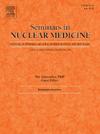Artificial Intelligence Augmented Cerebral Nuclear Imaging
IF 5.9
2区 医学
Q1 RADIOLOGY, NUCLEAR MEDICINE & MEDICAL IMAGING
引用次数: 0
Abstract
Artificial intelligence (AI), particularly machine learning (ML) and deep learning (DL), has significant potential to advance the capabilities of nuclear neuroimaging. The current and emerging applications of ML and DL in the processing, analysis, enhancement and interpretation of SPECT and PET imaging are explored for brain imaging. Key developments include automated image segmentation, disease classification, and radiomic feature extraction, including lower dimensionality first and second order radiomics, higher dimensionality third order radiomics and more abstract fourth order deep radiomics. DL-based reconstruction, attenuation correction using pseudo-CT generation, and denoising of low-count studies have a role in enhancing image quality. AI has a role in sustainability through applications in radioligand design and preclinical imaging while federated learning addresses data security challenges to improve research and development in nuclear cerebral imaging. There is also potential for generative AI to transform the nuclear cerebral imaging space through solutions to data limitations, image enhancement, patient-centered care, workflow efficiencies and trainee education. Innovations in ML and DL are re-engineering the nuclear neuroimaging ecosystem and reimagining tomorrow’s precision medicine landscape.
人工智能增强脑核成像。
人工智能(AI),特别是机器学习(ML)和深度学习(DL),在提高核神经成像能力方面具有巨大的潜力。探讨了当前和新兴的ML和DL在脑成像中SPECT和PET成像的处理、分析、增强和解释方面的应用。主要发展包括自动图像分割、疾病分类和放射学特征提取,包括低维一阶和二阶放射组学、高维三阶放射组学和更抽象的四阶深度放射组学。基于dl的重建、伪ct生成的衰减校正以及低计数研究的去噪都对提高图像质量有一定的作用。人工智能通过在放射配体设计和临床前成像中的应用在可持续性方面发挥作用,而联邦学习解决了数据安全挑战,以改善核脑成像的研究和开发。生成式人工智能也有潜力通过解决数据限制、图像增强、以患者为中心的护理、工作流程效率和培训生教育来改变核脑成像领域。机器学习和深度学习的创新正在重新设计核神经成像生态系统,并重新构想未来的精准医学前景。
本文章由计算机程序翻译,如有差异,请以英文原文为准。
求助全文
约1分钟内获得全文
求助全文
来源期刊

Seminars in nuclear medicine
医学-核医学
CiteScore
9.80
自引率
6.10%
发文量
86
审稿时长
14 days
期刊介绍:
Seminars in Nuclear Medicine is the leading review journal in nuclear medicine. Each issue brings you expert reviews and commentary on a single topic as selected by the Editors. The journal contains extensive coverage of the field of nuclear medicine, including PET, SPECT, and other molecular imaging studies, and related imaging studies. Full-color illustrations are used throughout to highlight important findings. Seminars is included in PubMed/Medline, Thomson/ISI, and other major scientific indexes.
 求助内容:
求助内容: 应助结果提醒方式:
应助结果提醒方式:


